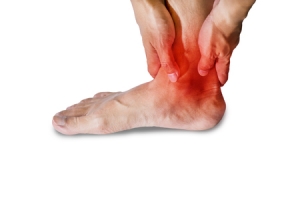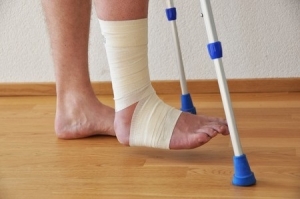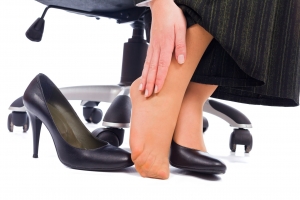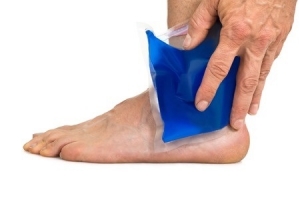Connect With Us
Blogs
Displaying items by tag: ankle sprains
Avoiding Podiatric Problems at the Beach
At Superior Foot & Ankle Care Center we know that our Los Angeles County patients are within driving distance of many beautiful California beaches. This favorite summertime excursion, however, can end in pain and discomfort for your feet or ankles if you fail to take the proper precautions. Below are some beach-day fun busters and how to prevent them.
Burns—while sunburn is an obvious concern that most people are aware of on a beach day, we find that many patients neglect to apply sunscreen diligently to their feet. It’s essential to use a water-resistant, broad-spectrum sunscreen that protects against both UVA and UVB rays with an SPF of at least 30. Be sure to apply the sunscreen to the tops and bottoms of your feet. Sitting in a sand chair the soles of your feet are exposed to direct sunlight and reflective rays off the sand. Reapply sunscreen to your feet after swimming or every two hours, whichever comes first.
Walking on hot sand or pavement can also cause the soles of your feet to burn. It may seem like a short trip to get to your beach blanket, but the temperatures of the sand can easily heat up enough to cause third-degree burns to the skin in a very short time. Always cover your feet before stepping out.
Jelly Fish Sting—Did you know that these creatures can still sting you even after they have washed up on the shore and died? Pack a small container of vinegar or baking soda in your beach bag and apply it to a jellyfish sting to relieve pain. Most stings will heal on their own within a few days. If yours appears to be getting worse instead of better, contact our Long Beach office at (562) 420-9800 office for an appointment so that our podiatrists, Dr. Victoria M. Foley and Dr. Constance Ornelas, can examine your wound and determine if it has become infected.
Ankle Sprain—some people enjoy adding a little sports activity to their beach day with a game of beach volleyball or frisbee. If you fall into this category, remember to bring sneakers to support your feet in sliding sands to avoid ankle sprains and other injuries.
Puncture Wound—sharp objects can easily be concealed in the sand. Wear shoes for beach walks to avoid cuts. If you do get a cut, clean it immediately and put antibacterial ointment and a bandage on the wound.
We hope you have lots of summer fun! If you have any foot or ankle issues, contact us for evaluation and treatment.
Sports Injury Lessons from Summer Olympians
At Superior Foot & Ankle Care Center we’re sure many of our Los Angeles County patients are following the athletes and events connected to the long-awaited Summer Olympics scheduled to take place in Tokyo later this summer. Along with thrilling competition, there’s sure to be some sports injuries such as the one sustained by Canadian shot put thrower, Brittany Crew. Crew was competing in Arizona at the Tucson Elite Classic in May when she suffered a freak accident that resulted in a Grade 2 sprain to her right ankle. When her left foot hit the toe board it slid, unexpectedly shifting all the force to the right ankle. Crew remembers hearing a pop and then her ankle went numb.
Treating Ankle Sprains
Fortunately, Crew is well on the road to recovery, and it looks like she should be in top form to compete in the Olympics. She has, however, decided to sit out the Olympic Trials in order to give her ankle additional time to heal. This wise move exemplifies one of the most important factors in recovering from an ankle injury: not rushing the rehabilitation. Unfortunately, many patients cut physical therapy short once their ankle stops hurting and this leads to the number one cause of repeated ankle sprains which is not recovering fully from an initial sprain. In addition to overstretched ligaments, the muscles that surround and support the ankle need to get stronger and this takes additional time. Other steps to achieving a full recovery include:
- Get medical treatment as soon as possible—ankle sprains require professional assessment. The severity of the sprain may not be obvious to the patient. Sometimes a sprain injury has also caused a fracture. Continuing to walk or play on a sprained ankle can lead to a worse injury. Contact our Long Beach office at (562) 420-9800 office for an appointment as soon as possible after an ankle-twisting injury so that our podiatrists, Victoria M. Foley and Dr. Constance Ornelas, can evaluate your injury and determine the best course of treatment.
- Use RICE—this self-treatment regimen is the best way to control pain and prevent further damage while you await your appointment. It stands for Rest, Ice, Compression, and Elevation.
- Follow the podiatrist’s instructions—you may need to take a break from a favorite sport to allow time to heal, use an ankle brace, or complete other treatment protocols to get back to full and normal use of your ankle but—take it from an Olympic athlete—it’s worth it!
Fall Sports Do’s and Don’ts
At Superior Foot & Ankle Care Center, we find that patients may not accurately understand the seriousness of decreased circulation to the lower extremities. The medical condition known as peripheral arterial disease (PAD) describes a situation where plaque (fatty deposits or cholesterol) have adhered to the walls of the arteries that lead to your legs and feet causing a partial or total blockage. This restricts the blood flow to the lower half of your body. PAD is often associated with diabetes and a significant cause of some of the more serious complications of the disease. When oxygen and nutrient-rich blood cannot get to your legs and feet in significant quantities, it makes it difficult to heal wounds and ulcers. This can lead to infection and, in extreme cases, amputation.
Recognize the Symptoms
There is a variety of symptoms of PAD that you may observe or experience. These include:
- Pain or cramping in your feet, legs, thighs or buttocks
- Feeling of coldness in your legs
- Hair loss on your toes and legs
- Bluish or reddish tinge to the skin on your feet or under the toenails
- Thickening and discoloration of your toenails
- Ulcers or wounds on your feet that have not healed after 8-12 weeks
If you notice any of these signs, you should contact our Long Beach office for an appointment by calling: (562) 420-9800. Our podiatrists, Dr. Victoria M. Foley or Dr. Constance Ornelas will want to examine your feet. There are a number of simple, non-invasive tests the foot doctor can perform to see if your symptoms point to PAD.
Reducing Your Risk
In addition to diabetes, PAD is also more common in patients who have high blood pressure, high cholesterol, heart disease or who have suffered a stroke. You are also at a higher risk for developing PAD if you are over the age of 50 or have a family history of PAD, heart disease or stroke. The good news, however, is that some risk factors for PAD are within your control to control. These include:
- Smoking
- Sedentary lifestyle
- Obesity
Making healthy lifestyle choices now and partnering with your podiatrist to monitor your foot health can help you prevent PAD or slow its progression. If you have additional questions about PAD, contact us at our Long Beach office in Douglas Park CA.
Celebrating Youth Sports Safely
During July, we celebrate National Youth Sports Week. As many of our young patients begin to think about conditioning for fall sports, we at Superior Foot & Ankle Care Center would like to share some information about how to protect your child’s feet and encourage safe sports participation.
Start Early
Participating in a sport has many benefits. It helps your child be physically fit and maintain a healthy weight and hopefully inspires them to develop a healthy lifestyle. While it may seem like the start of the school year is still far away, it takes time to get a body properly conditioned for a sport. If your child has spent the summer glued to their phone and video games, it’s essential that they get off the couch and start some regular physical activity. Check with your child’s coach to see if there are specific conditioning exercises that are recommended.
Put Your Best Foot Forward
Before the start of a new sports season, it’s a good idea to get a checkup with one of our podiatrists, Dr. Victoria M. Foley or Dr. Constance Ornelas. You can call our Long Beach office at (562) 420-9800 to schedule an appointment. The foot doctor can do a complete examination of your child’s feet and ankles and also follow up on any previous sports injuries. If there are chronic conditions such as weak ankles or Sever’s disease, the podiatrist can make recommendations for shoe designs and strategies to help reduce discomfort and risk for injury.
Check the Shoes
The most important piece of equipment for any sport is your shoes. Some tips to consider:
- Buy shoes that are designed for the sport that your child is doing. Different sports require different types of movement for your feet, and today’s sports shoes are designed to accommodate the specific moves associated with a particular sport.
- Get your child’s foot professionally measured. Even if your child has played the sport before, chances are they will have outgrown last season’s shoes.
- Don’t buy big—yes, it’s frustrating how often kids shoes need to be replaced, but a snug fit prevents blisters and feet slipping around which, can result in ankle sprains and other injuries.
If you have additional questions about your child’s feet and sports, don’t hesitate to contact us.
Common Reasons Exercise Programs Fail
At Superior Foot & Ankle Care Center we know the importance of exercise to your feet as well as the rest of your body. That’s why we applaud patients who make a resolution to get in shape in the New Year. Too often, however, by the time February rolls around many exercise plans have already been shelved. Below are some scenarios that can bring fitness plans to a halt and how to work around them.
“Let’s do this! I am going to work out every day to get in shape fast no matter what it takes.”
Not so fast, or you’ll likely end up with an injury. Achilles tendonitis, ankle sprains, and shin splints are just a few of the conditions that can be caused by doing too much too quickly. Not to mention that an overly ambitious start, especially if you’re out of shape, can lead to fatigue and discouragement before you even really get started. The best bet for long-term success is to do an activity or program that allows you to start slowly and gradually increase the level of your workout.
“I started a running program a few years ago and still have my shoes—yay! I won’t have to go out and buy new ones.”
Footwear is one of the most important factors in the success of an exercise program. Getting fitness shoes that are designed for the sport or activity, you’ll be doing is key. However, foot size can change over time. It’s best to get your foot measured professionally and try your shoes on to make sure they are still comfortable.
“I have a bunion, but I think if I put a pad over it I should be able to exercise without a problem.”
Before starting a new exercise program, it’s always best to consult your general practitioner and also your podiatrist. Our foot doctors, Dr. Victoria Foley or Dr. Constance Ornelas, will examine your feet completely. If you have a chronic foot problem, the podiatrist can recommend shoe styles and make suggestions for how to best accommodate your condition. In some cases, a custom orthotic device can increase comfort and performance.
“I’m going to join a gym—there are lots of good deals available now.”
Take the time to consider your likes and lifestyle. A gym is a good option if you like the classes and machines offered and you need to schedule around your work. Consider if you want a more social setting or if you like to work out alone, if you prefer an indoor or outdoor activity and how much time you can devote to your fitness plan. You’re more likely to stick to a plan that suits your interests and your availability.
If you experience any foot or ankle pain or discomfort when exercising, contact our Long Beach office by calling: (562) 420-9800.
Are You Plagued by Weak Ankles?
Do you constantly feel like your ankle is going to “give out?” Does walking on uneven surfaces, in high heels or stepping off a curb frequently cause your ankle to turn? If so, you may be suffering from chronic ankle instability, a condition that we at Superior Foot & Ankle Care Center know many patients find very frustrating.
Causes of Wobbly Ankles
In nearly all cases, at the root of a weak ankle condition is a previous ankle injury or problem. Common sources include:
- One or more ankle sprains
- Scar tissue formation following a sprain
- Fracture in the ankle joint bones
- Arthritis or other inflammatory condition of the ankle joint, tendons or joint lining
- Nerve damage in the ankle area, such as stretching, tearing or pinching of the ankle nerves
Sometimes patients fail to complete the full course of rehabilitation for an ankle injury. Physical therapy and other treatments are geared toward healing the overstretched ankle ligaments and also strengthening the muscles that surround the ankle. When the pain stops, that’s when a patient stops therapy. Unfortunately, that doesn’t mean the ankle is fully healed. Going back to normal activities can lead to another sprain because the ankle is still weak. The more injuries, the weaker the ankle becomes.
Breaking the Cycle
The first step is getting your ankles evaluated. Our podiatrists, Dr. Victoria Foley or Dr. Constance Omelas will examine your ankles and feet. The foot doctor will also ask questions about previous injuries, your medical history and recent activities. Digital x-rays (which can be done right in our Long Beach office) and/or other imaging studies may also be ordered to help get a clear picture of the condition of the ankle bones and joints.
Depending on the cause and extent of the ankle damage, a treatment plan will be developed which may include:
- Anti-inflammatory or steroidal medications prescribed on a temporary basis to decrease swelling
- Ankle braces or supports
- Immobilizing the ankle area if there is a fracture that needs to heal
- Physical therapy to strengthen and improve range of motion for ankle muscles
If you have weak ankles, don’t wait to get treatment. Contact us today by calling (562) 420-9800.
Protect Your Ankles
When you twist your ankle bones with a significant amount of force the ligaments around the outside of the bone may get over stretched or even tear. This is the definition of an ankle sprain. Symptoms of a sprained ankle include swelling, bruising, pain and tenderness in the ankle. At Superior Foot & Ankle Care Center we know that these injuries can be painful and debilitating. That’s why we want to offer the suggestions below for preventing ankle sprains from happening:
- Seek treatment promptly if you believe you may have sprained your ankle. Being able to walk on your foot is not a sign that the ankle is okay. In fact sometimes the pain may decrease after the initial injury but a sprain that is not diagnosed and treated promptly may not heal properly.
- Finish all treatment prescribed by the podiatrist for an ankle sprain. Did you know that one of the chief causes of ankle sprains are previous ankle sprains that were not fully rehabilitated? Don’t make the mistake of discontinuing physical therapy just because you are no longer in pain. In addition to the overstretched ligaments being healed it is necessary for the muscles that support the ligaments to be retrained and strengthened. If this does not occur, repeated sprains are likely and can result in chronic weak ankles.
- Scope out your path. Sometimes an acorn or small stone can be enough to cause your ankle to turn. Uneven pavement and curbs are also prime ankle twisting culprits. Pay attention!
- Don’t overfill your arms. If you are carrying so many bags and packages that you can’t see the pavement in front of you a slip or ankle turn is more likely.
- Toss shoes that are worn out. Stretched out backs and loose stitching increase the risk of slips and your ankle giving out on you.
If, despite all precautions, you do twist your ankle, contact our Long Beach office as soon after the injury as possible by calling: 562-420-9800. Our podiatrists, Dr. Victoria Foley and Dr. Constance Omelas will examine your ankle and possibly order x-rays to diagnose the condition. The correct treatment can then be determined to get you back to full health.
Shoe Choice Affects Foot Health for Women
At Superior Foot & Ankle Care Center we treat many women with foot problems that could have been avoided by choosing different shoes. Today, there are many attractive shoe designs that do not harm your feet. Short-term fashion choices can lead to long term foot health problems. Below are 3 types of shoes to avoid:
- High heels—shoes with high heels (2 inches or more) can cause a host of foot problems. First, the height of the heel can cause wobbling and instability which results in ankle sprains. High heels put extra strain on the muscles and ligaments of the ankle as they struggle to keep your foot in proper position. Continuing to wear high heels after a sprain is likely to set up a dangerous cycle of repeated sprains, increased weakness and eventually chronic ankle instability and pain. In addition, the design of high heels forces your toes forward, causing them to spend long hours cramped and squeezed. This increases the risk of bunions, hammertoes and other toe deformities.
- Stiff backed pumps—shoes with an overly hard heel counter can lead to a condition commonly referred to as “pump bump.” Officially known as Haglund’s deformity, a hard, bony enlargement forms on the back of the heel. When the back of pump rubs against the growth it causes irritation and inflammation. In some cases the bursa sac surrounding the deformity can become inflamed causing bursitis.
- Flip-flops—yes, these are comfortable and oh-so-easy to slip on and off but flip flops provide no support whatsoever for your feet. This increases the risk of your feet coming out of the shoe and getting cut or scraped and also the chances of twisting an ankle. The one exception to this is in gyms, public pools, spas and other places where covering your feet prevents contact with fungi and bacteria that can cause athlete’s foot, fungal toenail and
If a part of your foot, toe or ankle is causing you pain or you notice other symptoms such as bruising, swelling or redness, contact our Long Beach office for an appointment by calling: 562-420-9800. Our podiatrists, Dr. Victoria Foley and Dr. Constance Omelas will examine your feet and prescribe the correct treatment (in addition to changing your shoes) to relieve pain and prevent further injury.
Treating Sprained Ankles
Among the more common injuries we see at Superior Foot & Ankle Care Center are ankle sprains. In many instances these injuries come about on the playing field in soccer or football, for example, when your foot is planted and headed one way and then suddenly gets twisted in a different direction. Ankle sprains can also occur less dramatically, like stepping off a curb or missing the bottom step.
How Severe is the Sprain?
If you’ve sprained your ankle you will most likely experience pain, swelling and bruising. Ankle sprains can range from mild to severe. The degree of pain and swelling will correlate to the severity of the sprain. If you have sprained your ankle badly, you may not be able to bear weight or walk on it. Getting your ankle evaluated promptly and beginning rehabilitation as soon as possible is very important. Patients who delay treatment or just limp along at home until their ankle stops hurting are more likely to have repeated sprains and possibly long-term, chronic ankle pain and weakness.
Repairing the Damage
If you have swelling and bruising along with pain after twisting your ankle it should be evaluated by one of our board certified foot and ankle surgeons, Dr. Victoria Foley or Dr. Constance Omelas. After examining your ankle, the foot doctor will most likely want you to have a digital x-ray (which can be done conveniently right in our Long Beach office) to rule out a fracture, which can happen at the same time as a sprain. Once the podiatrist has assessed the degree of injury, an appropriate treatment plan can be developed.
The PRINCE Regimen
Until your appointment, you can care for your ankle using the PRINCE regimen:
Protection: Use a brace or other ankle support
Rest: Stay off your foot or avoid bearing weight by using crutches
Ice: Apply ice for 10-20 minutes every hour or two for the first 24 to 72 hours
Nonsteroidal anti-inflammatory medications: Ibuprofen or acetaminophen for pain relief
Compression: An ACE bandage or elastic compression wrap for the first 24-36 hours will help reduce swelling
Elevation: Keep your ankle above the level of your heart for 2-3 hours a day if possible
To get your ankle checked, contact us at: 562-420-9800 as soon as possible after the injury occurs.









